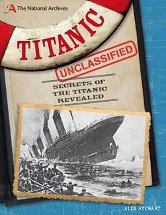Titanic unclassified : secrets of the Titanic revealed by Alex Stewart

A and C Black, 2012. ISBN 9781408160527.
Written for the 100 year anniversary of the Titanic sinking, this
book tells the story of the disaster using photographs, copies of
historical documents and pictures of artifacts to support the text.
The history of trans-Atlantic travel is outlined and the rivalry
between competing shipping lines explained to enable younger readers
to appreciate the enormity of the vessel and the magnificence of its
design.
Excellent diagrams illustrate the vessel's layout and facsimiles of
shipboard documents such as menus and telegrams lend a sense of
reality to readers who will be aware of the legendary event but
might be unable to identify with it through the mist of time.
Titanic's design and construction, with obvious reference to the
fabled 'watertight' compartments and inadequate life boats is
covered in some detail, as is her launch and sea trials. Stewart
also explains the vast gulf between the fabulously rich passengers
undertaking the passage for amusement and the cultivation of their
image amongst peers as opposed to the desperately poor migrants
seeking a more satisfactory life in the United States.
The series of events which culminated in the sinking are explained
and the sense of confusion, shock and chaos is conveyed in language
which is not overly technical or complex. Some content which has
been analysed and interpreted in different ways during the last
century is presented somewhat simplistically from one perspective,
however the account is generally reasonable and balanced.
The author has sourced some of his documentary and photographic
evidence from the British National Archives and the inclusion of the
word 'unclassified' both in the title and stamped over many
documentary facsimiles implies that this is previously withheld
information. This is not the case and whilst this book is very good
and will be a much valued and well used addition to library
collections, there is little to distinguish it from the many similar
publications which present the usual elements, using the same few
surviving photographs.
Rob Welsh